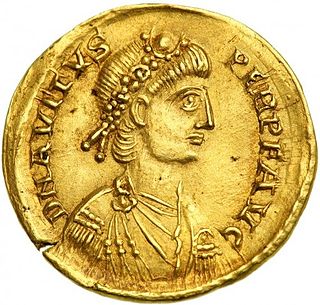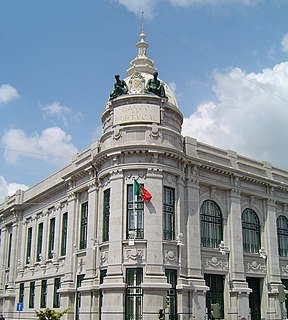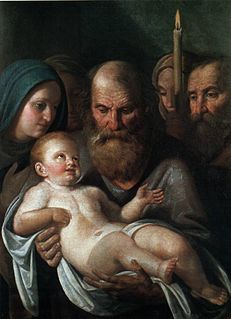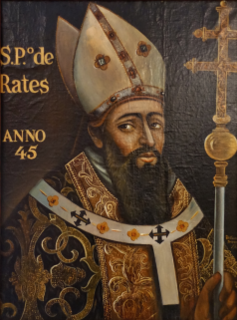Year 385 (CCCLXXXV) was a common year starting on Wednesday of the Julian calendar. At the time, it was known as the Year of the Consulship of Augustus and Bauto. The denomination 385 for this year has been used since the early medieval period, when the Anno Domini calendar era became the prevalent method in Europe for naming years.

Paulus Orosius, less often Paul Orosius in English, was a Roman priest, historian and theologian, and a student of Augustine of Hippo. It is possible that he was born in Bracara Augusta, then capital of the Roman province of Gallaecia, which would have been the capital of the Kingdom of the Suebi by his death. Although there are some questions regarding his biography, such as his exact date of birth, it is known that he was a person of some prestige from a cultural point of view, as he had contact with the greatest figures of his time such as Augustine of Hippo and Jerome of Stridon. In order to meet with them Orosius travelled to cities on the southern coast of the Mediterranean Sea, such as Hippo Regius, Alexandria, and Jerusalem.

Eparchius Avitus was Roman emperor of the West from July 455 to October 456. He was a senator of Gallic extraction and a high-ranking officer both in the civil and military administration, as well as Bishop of Piacenza.

Pelagius was a theologian who advocated free will and asceticism. He was accused by Augustine of Hippo and others of denying the need for divine aid in performing good works. They understood him to have said that the only grace necessary was the declaration of the law; humans were not wounded by Adam's sin and were perfectly able to fulfill the law without divine aid. Pelagius denied Augustine's theory of original sin. Adherents of Pelagius cited Deuteronomy 24:16 in support of their position. Pelagius was declared a heretic by the Council of Ephesus in 431. His interpretation of a doctrine of free will became known as Pelagianism.

The True Cross is the name for physical remnants which, by the tradition of some Christian churches, are said to be from the cross upon which Jesus was crucified.
A number of claimed relics associated with Jesus have been displayed throughout the history of Christianity. While some individuals believe in the authenticity of Jesus relics, others doubt their validity. For instance, the sixteenth-century philosopher Erasmus wrote about the proliferation of relics, and the number of buildings that could be constructed from wooden relics claimed to be from the crucifixion cross of Jesus. Similarly, at least thirty Holy Nails were venerated as relics across Europe in the early 20th century. Part of the relics are included in the so-called Arma Christi, or the Instruments of the Passion.

Braga is a city and a municipality in the northwestern Portuguese district of Braga, in the historical and cultural Minho Province. The city has a resident population of 192,494 inhabitants, representing the seventh largest municipality in Portugal. Its area is 183.40 km2. Its agglomerated urban area extends from the Cávado River to the Este River. It is the third-largest urban centre in Portugal.

Alcimus EcdiciusAvitus was a Latin poet and bishop of Vienne in Gaul. His fame rests in part on his poetry, but also on the role he played as secretary for the Burgundian kings.
Dedication is the act of consecrating an altar, temple, church, or other sacred building. It also refers to the inscription of books or other artifacts when these are specifically addressed or presented to a particular person. This practice, which once was used to gain the patronage and support of the person so addressed, is now only a mark of affection or regard. In law, the word is used of the setting apart by a private owner of a road to public use.

Dume is a former freguesia and former bishopric in the municipality of Braga, northern Portugal, which remains a Catholic titular see.
Iria Flavia or simply Iria in Galicia, northwestern Spain, is an Ancient settlement and former bishopric in the modern municipality of Padrón, which remains a Catholic titular see.

Simeon at the Temple is the "just and devout" man of Jerusalem who, according to Luke 2:25–35, met Mary, Joseph, and Jesus as they entered the Temple to fulfill the requirements of the Law of Moses on the 40th day from Jesus' birth at the presentation of Jesus at the Temple.

The Kingdom of the Suebi, also called the Kingdom of Gallæcia or Suebi Kingdom of Gallæcia, was a Germanic post-Roman kingdom that was one of the first to separate from the Roman Empire. Based in the former Roman provinces of Gallaecia and northern Lusitania, the de facto kingdom was established by the Suebi about 409, and during the 6th century it became a formally declared kingdom identifying with Gallaecia. It maintained its independence until 585, when it was annexed by the Visigoths, and was turned into the sixth province of the Visigothic Kingdom in Hispania.

The Roman Catholic Archdiocese of Braga is an archdiocese of the Latin Rite of the Catholic Church in Portugal.
The region around the city of Braga, in modern Portugal, was an important centre for the spreading of Christendom in the Iberian Peninsula. This is reflected in the number of religious personalities associated with the region and the fact that many ecumenical councils were held in the city.

Saint Peter of Rates, also known in English as Saint Peter of Braga, is traditionally considered to be the first bishop of Braga between the years AD 45 and 60. Tradition says he was ordered to preach the Christian faith by Saint James the Great, and that Peter of Rates was martyred while attempting to convert the locals to the Christian faith in northern Portugal. The ancient Breviary of Braga and the Breviary of Evora hold that Peter of Rates was a disciple of Saint James and preached at Braga. However, the Bollandists argue that this claim is "purely traditional."

Saint James Intercisus, also known as Saint James the Mutilated was a Syriac Christian saint born in Beth Huzaye in Persia. His epithet, Intercisus, is derived from the Latin word for "cut into pieces," which refers to the manner of his martyrdom: he was slowly cut into twenty-eight pieces. His death started the Roman-Sassanid War (421-422).
John II was bishop of Jerusalem from AD 387 to AD 417. John II succeeded to the episcopal throne of Jerusalem on the death of Cyril in 386. He was the author, according to an increasing number of modern scholars, of the five Mystagogical Catecheses traditionally ascribed to his predecessor Cyril.

Saint Praejectus, Prejectus or Projectus (625–676) was a bishop of Clermont, who was killed together with Amarinus. Born in the Auvergne to the lesser nobility, he studied under Genesius of Clermont. He was ordained a priest and, with the approval of Childeric II, became bishop of Clermont in 666.

Stephen traditionally venerated as the protomartyr or first martyr of Christianity, was, according to the Acts of the Apostles, a archdeacon in the early Church at Jerusalem who angered members of various synagogues by his teachings. Accused of blasphemy at his trial, he made a speech denouncing the Jewish authorities who were sitting in judgment on him and was then stoned to death. His martyrdom was witnessed by Saul of Tarsus, also known as Paul, a Pharisee and Roman citizen who would later become a Christian apostle.













